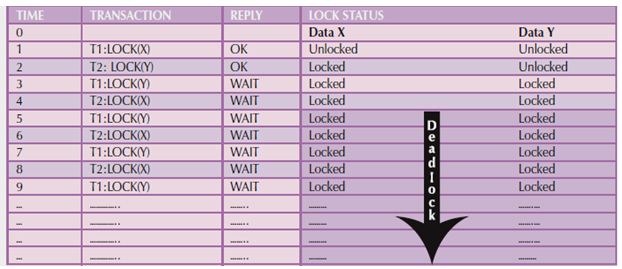Deadlocks in DBMS
A deadlock occurs when two transactions wait indefinitely for each other to unlock data. For example, a deadlock occurs when two transactions, T1 and T2, exist in the following mode:
T1 = access data items X and Y
T2 = access data items Y and X
If T1 has not unlocked data item Y, T2 cannot begin; if T2 has not unlocked data item X, T1 cannot continue.
Consequently, T1 and T2 each wait for the other to unlock the required data item. Such a deadlock is also known as a deadly embrace. The following diagram represents how a deadlock condition is created.
You May Also Like:
Transaction and Its Properties
Concurrency Problems
Deadlocks in DBMS
The preceding example used only two concurrent transactions to demonstrate a deadlock condition. In a real-world DBMS, many more transactions can be executed simultaneously, thereby increasing the probability of generating deadlocks. Note that deadlocks are possible only when one of the transactions wants to obtain an exclusive lock on a data item; no deadlock condition can exist among shared locks
The three basic techniques to control deadlocks are:
• Deadlock prevention
A transaction requesting a new lock is aborted when there is the possibility that a deadlock can occur. If the transaction is aborted, all changes made by this transaction are rolled back and all locks obtained by the transaction are released. The transaction is then rescheduled for execution. Deadlock prevention works because it avoids the conditions that lead to deadlocking.
• Deadlock detection
The DBMS periodically tests the database for deadlocks. If a deadlock is found, one of the transactions (the “victim”) is aborted (rolled back and restarted) and the other transaction continues.
• Deadlock avoidance
The transaction must obtain all of the locks it needs before it can be executed. This technique avoids the rolling back conflicting transactions by requiring that locks be obtained in succession. However, the serial lock assignment required in deadlock avoidance increases action response times.
The choice of the best deadlock control method to use depends on the database environment. For example, if the probability of deadlocks is low, deadlock detection is recommended. However, if the probability of deadlocks is high, deadlock prevention is recommended. If response time is not high on the system’s priority list, deadlock avoidance might be employed. All current DBMSs support deadlock detention in transactional databases, while some DBMSs use a blend of prevention and avoidance techniques for other types of data, such as data warehouses or XML data.
You May Also Like:


